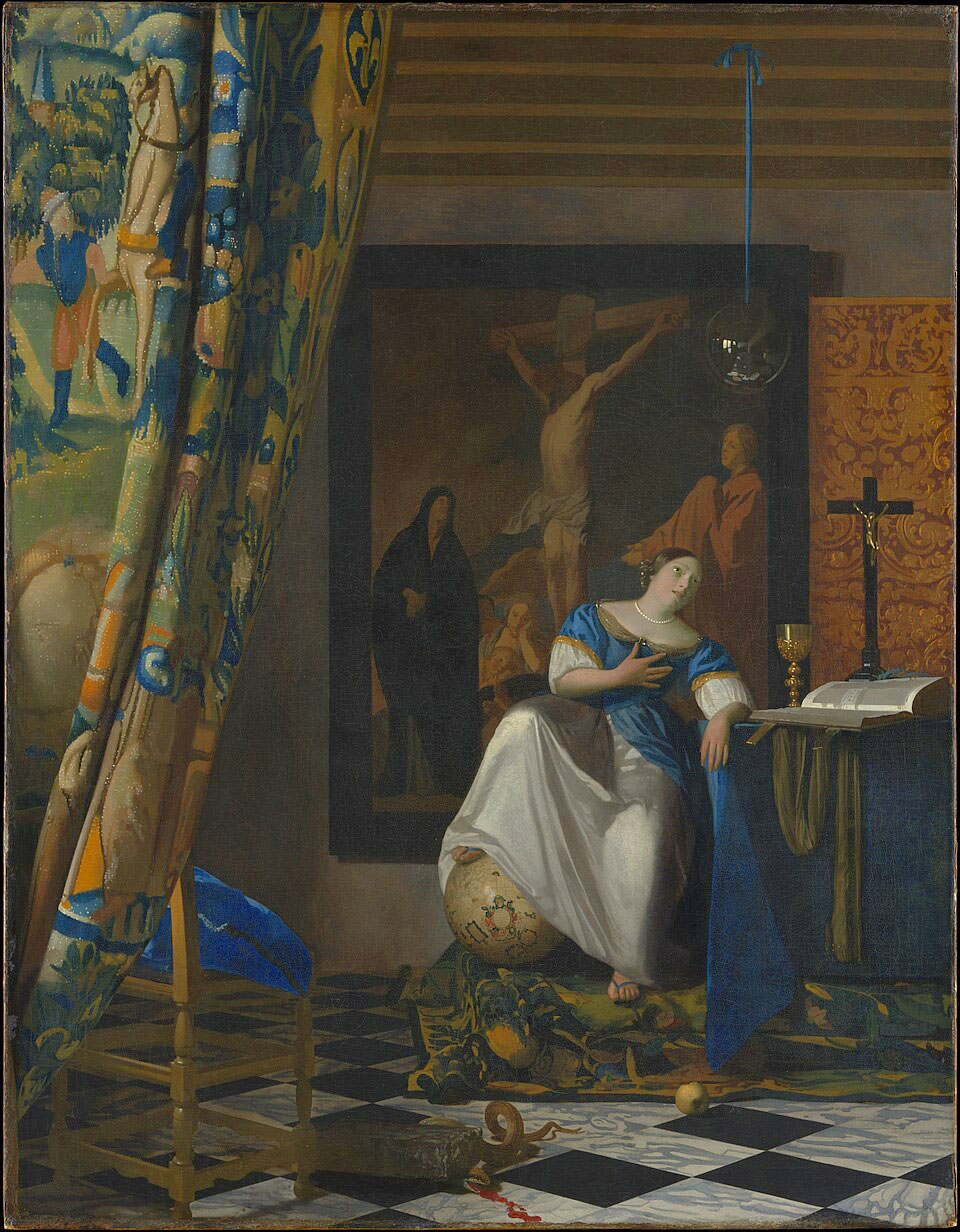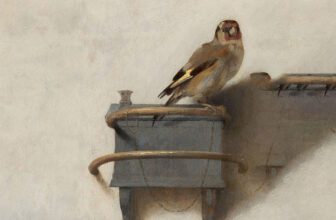
Meaning of Johannes Vermeer’s “Allegory of Faith” Painting
In a calm room of The Metropolitan Museum of Art in New York City, one might find themselves standing before a canvas unlike any other created by Johannes Vermeer. Renowned for his exquisite depictions of domestic interiors, filled with soft light and contemplative figures, Vermeer crafted only a handful of paintings in his lifetime, each one a window into the serene world of 17th-century Dutch life. Yet among these windows, one stands apart, not merely a depiction of daily life, but an enigmatic visual sermon. That painting is Allegory of the Catholic Faith, commonly referred to as Allegory of Faith, a symbolic masterpiece created circa 1670–1674.
Who Was Johannes Vermeer?
Before we immerse ourselves in the painting itself, we must first look into the life of the man behind the brush. Johannes Vermeer (1632–1675) was a Dutch Baroque painter who lived his entire life in Delft. Although he died in relative obscurity and financial ruin, Vermeer is now celebrated as one of the greatest painters of the Dutch Golden Age. He specialized in intimate domestic scenes, often portraying women engaged in quiet, introspective activities, reading letters, playing instruments, or pouring milk.
Vermeer was known for his mastery of light and his ability to elevate the mundane into the sublime. Yet Allegory of Faith represents a bold departure from his usual subjects. It is one of only two known allegorical paintings by Vermeer, the other being The Art of Painting, and it uniquely intertwines his artistic virtuosity with an overt religious message.
Painting in an Age of Division
By the 1670s, the Netherlands was deeply Protestant, and Catholicism, though practiced in private, was outlawed in public. Vermeer himself was raised Protestant but converted to Catholicism upon his marriage to Catharina Bolnes in 1653. His wife came from a devout Catholic family, and their home included a hidden church (a schuilkerk) for clandestine worship. Allegory of Faith, created during the final years of his life, reflects this private yet fervent religious identity.
It is believed that Allegory of Faith was painted for a Catholic patron, possibly for use in a hidden chapel or as a devotional image within a private home. Unlike his more secular works, this painting is unapologetically theological in its purpose and saturated with symbolism.
What Is the “Allegory of Faith” Painting All About?
At its core, Allegory of Faith is a visual representation of the virtue of faith, specifically Catholic faith. It’s part of a larger European tradition of religious allegories, in which abstract virtues are personified and surrounded by symbolic elements. This approach allowed painters to explore moral and spiritual concepts through visual storytelling.
In the painting, Vermeer presents a serene, idealized woman dressed in rich white and blue garments, seated beside a table in an elegant room. Her gaze is turned upward, eyes fixed on a glass sphere hanging from the ceiling, a symbol of divine presence or the perfection of God’s creation. Every object around her is imbued with theological meaning, forming a cohesive narrative about the nature of faith.
What Is Happening in the Painting?
To the untrained eye, the scene may appear tranquil and simple. A young woman sits in quiet contemplation. Yet every element contributes to an intricate visual metaphor:
The Woman: She represents the personification of “Faith.” Her expression is one of rapture and spiritual awe. Her left hand is placed gently on her chest, indicating internal conviction, while her right foot rests on a terrestrial globe, symbolizing spiritual triumph over worldly matters.
The Glass Orb: Suspended from the ceiling, the orb reflects light and space, a motif borrowed from Cesare Ripa’s Iconologia, a popular emblem book of the time. In the Catholic allegorical tradition, it represents the clarity and unity of God’s universe. Its placement above her line of sight signifies her vision reaching beyond the earthly realm.
The Curtain and Tapestry: As in many Vermeer works, a curtain is drawn back to reveal the scene, evoking the unveiling of divine truth or a sacred moment being made visible to the viewer. The rich tapestry serves not just decorative purposes, but adds depth and grandeur to the setting, suggesting the majesty of faith.
The Crucifix, Chalice, and Bible: Placed on the table near the woman, these objects reference the Holy Sacrament and the Passion of Christ. The large gilt chalice and missal directly reflect Catholic ritual, reinforcing the painting’s counter-Reformation symbolism.
The Apple: A green apple lies on the floor, symbolizing original sin, echoing the fall of man in the Garden of Eden. Its presence juxtaposed with the symbols of redemption points to the journey from sin to salvation.
The Snake and the Stone: At the woman’s feet, a serpent lies crushed by a cornerstone. This vivid detail directly refers to Genesis 3:15 and Christian iconography where Christ is the “cornerstone” who defeats Satan. The snake, representing heresy or temptation, lies vanquished, a clear metaphor for the triumph of Catholic truth.
The Painting Behind the Woman: Hanging on the back wall is an image of the Crucifixion. This painting-within-a-painting anchors the room in Christ’s sacrifice and underscores the central tenet of Christian faith: redemption through Jesus.
Symbolism and Meaning: The Language of Allegory
To fully appreciate Allegory of Faith, one must decode its symbols as if reading a sacred text. Vermeer’s painting becomes a silent sermon, echoing the Counter-Reformation’s emphasis on using art to educate and inspire the faithful.
Personification of Faith: Drawing on Ripa’s Iconologia, Vermeer’s female figure embodies the theological virtue of faith. Her upward gaze shows devotion, and her foot on the globe denotes detachment from material concerns.
The Glass Sphere: Often seen in depictions of Saint Thomas Aquinas and Baroque science, it also echoes Vanitas imagery. Here, it suggests both the perfection of divine order and the fragility of human understanding.
The Crushed Serpent: Referencing the Virgin Mary’s victory over sin (common in Catholic iconography), it symbolizes the defeat of Protestant heresy from a Catholic point of view, controversial in a Protestant-dominated Holland.
The Crucifixion Painting: Echoing works by Christoffel van Sichem or Jacob Jordaens, it reinforces Catholic piety and the doctrine of salvation through Christ’s suffering, central to post-Tridentine theology.
The Chalice and Bible: These are visual arguments in favor of Catholic ritual. In particular, the chalice, elevated in the Mass, distinguishes Catholic liturgy from Protestant practice.
Costume and Setting: Her opulent dress and the stately setting suggest the richness of faith and the heavenly reward for true believers.
Artistic Style and Technique: A Vermeer Signature with a Twist
Although the subject matter is religious, Vermeer applies the same technical mastery found in his secular works. The painting uses:
Camera Obscura Techniques: Scholars believe Vermeer used this optical device to compose his interiors and capture precise lighting. The soft gradation of shadows, reflective surfaces, and naturalistic textures all point to this approach.
Chiaroscuro and Composition: Strong light from the left illuminates the figure and the table, creating contrast and drawing attention to key symbols. The arrangement guides the viewer’s gaze in a spiritual ascent, from the crushed snake on the floor, through the chalice on the table, to the woman’s gaze lifted to the orb.
Color and Texture: Rich blues and golds, traditional Marian colors, symbolize purity and divinity. The meticulous rendering of satin, wood, metal, and glass showcases Vermeer’s peerless skill in portraying light and materiality.
Reception and Legacy: A Puzzling Masterpiece
Allegory of Faith has always occupied a complex place in Vermeer’s oeuvre. While his genre scenes are celebrated for their subtle humanism, this work is overtly didactic and symbolic. Critics have sometimes viewed it as stiff or unnatural compared to his other works, pointing to the somewhat theatrical pose of the woman and the densely packed symbolism.
Yet this complexity is precisely what makes Allegory of Faith so compelling. It challenges viewers to move beyond the aesthetic and into contemplation, much like the role of sacred art in Catholic worship. For modern audiences, the painting invites not just admiration but interpretation, acting as a visual puzzle box filled with theological insight.
Where Is the Allegory of Faith Painting Today?
Today, Allegory of Faith resides in The Metropolitan Museum of Art in New York City. It is part of the Robert Lehman Collection and remains one of the few Vermeer works housed outside Europe. The painting is preserved under ideal conditions, and it continues to draw art historians, theologians, and everyday visitors alike, each attempting to decipher its mysteries.
Faith in the Frame
Allegory of Faith is not just a painting; it’s a spiritual statement, a theological treatise rendered in oils and light. In a time of religious suppression and silent resistance, Vermeer dared to craft a vision of Catholic devotion, layered, luminous, and reverent. It stands today not only as a testament to his artistic genius but also as a window into the religious soul of a divided Dutch Republic.
While it may lack the immediate emotional intimacy of Girl with a Pearl Earring or The Milkmaid, Allegory of Faith offers something deeper: a meditation on transcendence, sacrifice, and divine truth. In doing so, Vermeer proved that art could do more than imitate life, it could uplift the spirit and speak of eternal things.




